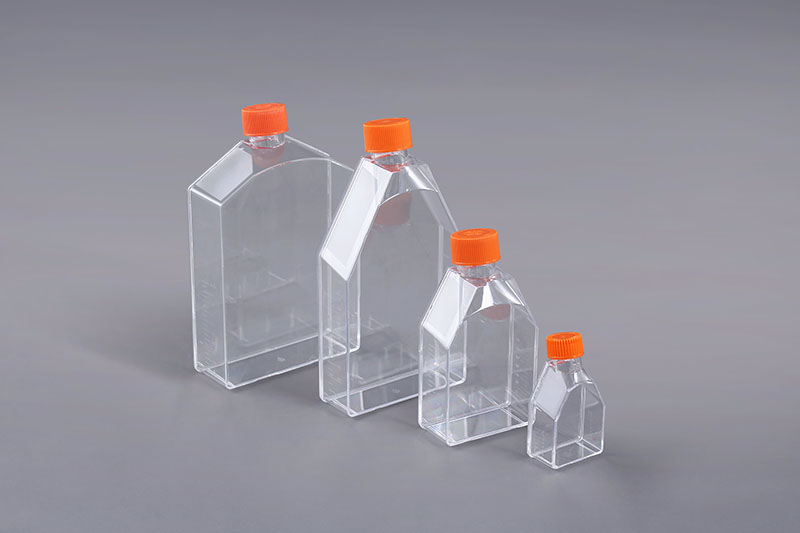ขวดเพาะเลี้ยงเซลล์ส่วนใหญ่จะใช้สำหรับการเพาะเลี้ยงเซลล์ขนาดเล็กและขนาดกลาง ดังนั้น เซลล์ชนิดใดที่สามารถเพาะเลี้ยงในขวดเพาะเลี้ยงเซลล์?
เซลล์มีหลายประเภท ซึ่งแบ่งออกเป็นเซลล์ที่ยึดติดและเซลล์แขวนลอย ตามรูปแบบการเติบโต การเติบโตของเซลล์ยึดเกาะต้องมีพื้นผิวรองรับที่สามารถยึดติดได้ และเซลล์ต้องอาศัยปัจจัยการยึดติดที่หลั่งออกมาเองหรือจัดเตรียมไว้ในอาหารเลี้ยงเชื้อ เพื่อที่จะเติบโตและขยายพันธุ์บนพื้นผิวนี้ การเติบโตของเซลล์แขวนลอยไม่ได้ขึ้นอยู่กับพื้นผิวของตัวรองรับและเติบโตในสารแขวนลอยในอาหารเลี้ยงเชื้อ ขวดเพาะเลี้ยงเซลล์โดยทั่วไปทำจากวัตถุดิบโพลีสไตรีนโปร่งใส ข้อกำหนดทั่วไป ได้แก่ 25cm2, 75cm2, 175cm2 และ 225cm2 พื้นผิวด้านล่างของขวดเซลล์ได้รับการออกแบบด้วยรูปทรงโค้งเพื่อลดมุมสัมผัสตายเมื่อทำการปิเปตเซลล์ สามารถใช้ได้ทั้งการเพาะเลี้ยงเซลล์ยึดเกาะและการเพาะเลี้ยงแบบสถิตของเซลล์แขวนลอย ชนิดเซลล์ที่ใช้ได้มีดังนี้:
เซลล์ที่อยู่ติดกัน: เซลล์ Vero, เซลล์ HEK 293, เซลล์ CAR-T, MRC5, เซลล์ CEF, มาโครฟาจในช่องท้องของสุกร, เซลล์มัยอีโลมา, เซลล์ DF-1, เซลล์ ST, เซลล์ PK15, Marc145 เซลล์ เป็นต้น
เซลล์แขวนลอย: เซลล์ CHO เซลล์แมลง เซลล์ BHK21 และเซลล์ MDCK เป็นต้น
ควรสังเกตว่าถ้า ขวดเพาะเลี้ยงเซลล์ ถูกใช้เพื่อการเพาะเลี้ยงเซลล์ที่ยึดเกาะพื้นผิวของ ขวดต้องมีการปรับเปลี่ยนเป็นพิเศษเพื่อเพิ่มความชอบน้ำเพื่อให้เป็นไปตามลักษณะการเจริญเติบโตของเซลล์ที่ยึดเกาะ เมื่อใช้ในการเพาะเลี้ยงเซลล์แบบแขวนลอย ไม่จำเป็นต้องดูแลเป็นพิเศษ
The FAI climbed 5.9 percent year-on-year in the first 11 months of 2018, quickening from the 5.7-percent growth in Jan-Oct, the National Bureau of Statistics (NBS) said Friday in an online statement.
The key indicator of investment, dubbed a major growth driver, hit the bottom in August and has since started to rebound steadily.
In the face of emerging economic challenges home and abroad, China has stepped up efforts to stabilize investment, in particular rolling out measures to motivate private investors and channel funds into infrastructure.
Friday's data showed private investment, accounting for more than 60 percent of the total FAI, expanded by a brisk 8.7 percent.
NBS spokesperson Mao Shengyong said funds into weak economic links registered rapid increases as investment in environmental protection and agriculture jumped 42 percent and 12.5 percent respectively, much faster than the average.
In breakdown, investment in high-tech and equipment manufacturing remained vigorous with 16.1-percent and 11.6-percent increases respectively in the first 11 months. Infrastructure investment gained 3.7 percent, staying flat. Investment in property development rose 9.7 percent, also unchanged.
 English
English



















































